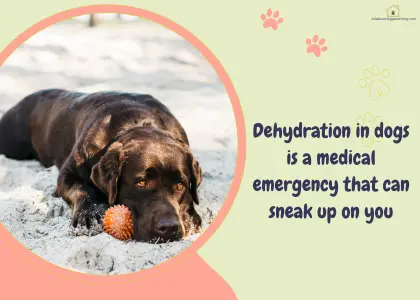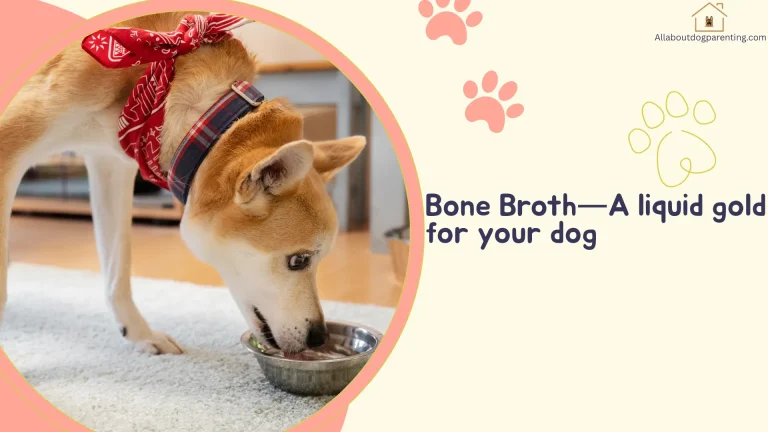Signs of Dehydration in Dogs Every Pet Parent Should Know
I have seen first hand how dehydration in dogs sneaks up on you when you least expect it. A dog rescued by a shelter I volunteer at refused to move indoors on a hot afternoon, and his handlers noticed that he was lethargic, stopped drinking or eating, and was generally disinterested in his surroundings. The team attributed it to the trauma of being abandoned. As it turned out, he was severely dehydrated, and by the time medical help was sought, it was already critically ill.
Dehydration can have that effect on dogs. If signs of dehydration in dogs go unrecognized, the impact on their health can be dire. Because dehydration isn’t just thirst, it’s lack of adequate water in the body. This can cause critical systems like temperature regulation, circulation and organ function start to break down.
To make sure you can stay on top of this very real risk to your pet’s health and well-being, I’ve put together this guide on dog dehydration, covering symptoms, common causes and risks, and what to do if your dog gets dehydrated, based on my experience as a dog mom of 15 years and backed by expert advice. I can’t stress enough: acting fast can save a pup’s life.
What is Dehydration in Dogs?
By definition, dehydration in dogs happens when a dog loses more fluids, both water and electrolytes, than it takes in. Think of it as an extreme fluid imbalance. Veterinarian Dr. Michelle Diener explains, “Water is at the heart of your dog’s health, supporting digestion, temperature control and organ function. When a dog isn’t getting enough fluids, its body literally can’t move nutrients or regulate heat properly.”
This can become fatal if not addressed in time. Even in its mild form, canine dehydration affects blood circulation and can throw electrolytes like sodium and potassium out of balance, hurting muscle and nerve activity. If you’re asking, “What is dehydration in dogs?” The simplest answer I can offer is that it is a medical emergency, and must be treated as such. Early awareness that your dog is losing water can keep minor symptoms from turning into major organ failure or heatstroke.
Common Signs of Dehydration in Dogs

Since timely intervention can mean the difference between life and death, every pet parent must be aware of signs of dehydration in dogs. Keep an eye on these red flags, especially during hot weather or when your pet is unwell:
Loss of Skin Elasticity
One of the simplest ways to confirm whether you’re dealing with dehydration is the dog skin tent test. Pinch up a patch of loose skin on your dog’s shoulder or back. In a well-hydrated dog, the skin will immediately snap back to place. In a dehydrated dog, the skin stays “tented” or returns slowly, showing poor skin elasticity.
Veterinarian Dr. David Israel explains, “Well-hydrated animals normally have elastic skin, so when one pulls up on their skin, it snaps back down quickly. However, whether or not skin elasticity must be interpreted along with other symptoms because aging or certain conditions can affect skin tone.”
Dry Nose, Gums, and Mouth
A healthy dog’s gums and nose are cool and moist. If you notice your dog’s nose or mouth is unusually dry, or their saliva has become thick and sticky, you could be dealing with dog dehydration symptoms.
Dr. Diener explains, “Dehydration can make saliva ropey and gums tacky. Loss of water and electrolytes in the body can also result in signs such as dry mouth, parched tongue, and a lack of saliva.” These are your cue to get some water and electrolyte into your pet as soon as possible, and see a vet at the earliest.
Sunken Eyes & Lethargy
When fluid levels drop significantly, fat pads behind the eyes shrink and the eyes look sunken into the sockets. You may also notice your dog is unusually lethargic or just not themselves. Dogs that are underhydrated often lie down more, seem weak and reluctant to play or move much.
Dr Israel says, “The presence of sunken eyes when your dog is also lethargic can be a warning sign they’re dehydrated.” So, if your pet seems unusually tired and you spot that glassy-eyed sunken look, dehydration should be high on your list of suspects, along with any underlying illness.
Excessive Panting or Fast Heartbeat
Dogs naturally pant to cool off, but if you see panting that is much heavier or faster than normal, especially with no obvious exercise, it could mean trouble. Panting too much is the body’s way of losing heat, and without enough water it becomes a vicious cycle.
Likewise, a rapid heartbeat can follow dehydration as the body works to circulate thinner blood. Always remember: a dog who is panting excessively after being in the sun or a long runmay be on the edge of overheating and dehydration. So, keep an eye out. If the panting doesn’t slow with rest, and you see other signs like dry mouth or rapid pulse, you may well have to seek veterinary help.
Causes of Dehydration in Dogs
Dehydration in dogs can be triggered by various factors.
- The most common culprits are heat and exercise. On hot days or during strenuous play, your dog can lose fluids rapidly by panting and panting
- Your dog can also dehydrate fast if they overheat
- Dehydration can also be the side effect of illness. Any episode of vomiting or diarrhea flushes water and electrolytes from the body. Likewise, when the body temperature rises due to a fever, fluid loss can become more rapid, leading to dehydration
- Chronic health issues can also be to blame. For instance, kidney disease or uncontrolled diabetes often cause dogs to urinate a lot and lose fluids
- Sometimes it’s as simple as not getting enough water. A forgotten empty bowl or being away from home without water can do it
Risks and Complications of Untreated Dehydration
Dog dehydration risks shouldn’t be underestimated. If left unchecked, it can spiral into life-threatening problems. Initially your dog’s body will divert blood to vital organs, but prolonged fluid deficit can lead to hypovolemic shock , where the heart can’t pump enough blood.
Internally, organs like the kidneys are especially at risk. Dr Israel explains, “Severe dehydration can lead to kidney failure, loss of consciousness, and in extreme cases, be fatal.” Puppies, seniors, and dogs with chronic illnesses are particularly vulnerable. Small puppies can dehydrate in hours, and an older dog may not tolerate even mild dehydration well.
The bottom line is that severe dehydration in dogs is dangerous. It’s not a minor health blip, it can trigger organ shutdown, heatstroke, or shock. The good news is that catching dehydration early usually prevents these complications, which is why knowing the warning signs is so important.

How to Check If Your Dog Is Dehydrated
If you suspect dehydration, there are simple at-home tests you can try to check dog dehydration, though none replace a vet exam. Here is check for dog dehydration:
- Perform the skin tent test
- Another quick check is the gum color test. Press a finger gently on your dog’s gums and see how fast color returns. In a well-hydrated dog, the blanched spot turns pink almost immediately. If refill time is delayed, that could indicate dehydration.
- Watch your dog’s behavior. If they’re unusually lethargic or their eyes look dull, take note
However, these home dog dehydration tests are helpful first steps, but if something seems off or your dog has underlying issues, call the vet for a thorough check-up.
What to Do If You Suspect Dehydration
If your dog shows early signs of dehydration, act fast at home. Offer fresh, cool water immediately, but do it slowly. Encourage small sips every few minutes rather than letting them gulp a bowlful. A few drops or ice chips at a time can be easier on the stomach if they’re queasy. You can also try a splash of low-sodium broth or a doggy electrolyte solution to entice drinking. Avoid forcefully flushing water into the mouth, as that can cause aspiration or vomiting.
Watch your dog closely. If symptoms persist or worsen, it’s time to call the vet. Veterinarian Dr. Jerry Klein warns, “If your dog has any of the symptoms of dehydration or you suspect heatstroke, take him to the vet immediately. This is considered a medical emergency.”
The vet will often administer fluids, usually subcutaneous or intravenous, to quickly rehydrate and rebalance electrolytes. While mild cases can be managed at home, when in doubt, seeking timely medical attention is the safest recourse. Remember: even mild dehydration can escalate, so quick action and vet input are key.
Preventing Dehydration in Dogs

It’s far easier to prevent dehydration than to treat it. Always keep clean, fresh water available for your dog, both indoors and out. I, for example, always carry a portable water bottle and collapsible bowl on long walks and hikes.
If your dog isn’t big on drinking water, a little encouragement from you can go a long way. Wash the bowls daily and refill twice a day so water is inviting. Try tossing in a few ice cubes or adding a splash of bone broth to entice your dog to lap up.
It also helps to adjust activities on hot days. Walk in the morning or evening, take breaks in shade, and never leave your pup in a hot car. If dehydration is becoming a recurrent issue, you may also want to consider diet tweaks. Wet food or dry kibble soaked in water adds hydration. You can top it up with hydrating treats like carrot sticks or watermelon. These simple dog hydration tips help keep your dog hydrated and happy all year.
FAQs About Dog Dehydration
- How much water should my dog drink daily?
A general rule is about 1 ounce (30 mL) of water per pound of body weight each day. For example, a 50-pound dog needs roughly 50 ounces daily. That amounts to about 6 cups. The requirement with hot weather or exercise. If you’re unsure about your dog’s water intake, ask your vet, or compare their weight to water intake charts provided by veterinary experts. And make sure that your dog has access to clean, cool water at all times.
- Are some breeds more prone to dehydration?
Yes, flat-faced or brachycephalic breeds like Bulldogs, Pugs, Shih Tzus tend to dehydrate more easily. Dogs cool off by panting. If they can’t breathe properly, they’re going to have a harder time maintaining their temperature. These dogs struggle to lose heat and so can overheat and dehydrate quickly. Similarly, thick-coated or active working breeds, like huskies or shepherds, need extra care in heat. If you have a breed known for breathing or heat issues, be extra vigilant about water and shade.
- Can dehydration happen in winter?
Absolutely. In winter, indoor heating and dry air can dry out your dog’s skin and mucous membranes, and they may drink less because they’re not panting heavily. Cold weather can give a false sense of security, but pets still require hydration to function properly. Even outside, fresh water can freeze. So continue offering water, a heated bowl helps, and watch for the same red flags like lethargy, dry gums, or sunken eyes that indicate your dog isn’t getting enough.
- Can electrolyte drinks for humans be given to dogs?
Generally, no. Human sports drinks or Pedialyte often contain too much sodium or sugar for dogs. There is simply no evidence that Pedialyte is any more beneficial to a mildly dehydrated dog than just regular water. In fact, the higher salt and sugar can be harmful, especially for dogs with health issues. If you think your dog needs electrolytes, it’s safest to consult your vet. They may recommend a canine-formulated electrolyte solution or simply confirm that plain water, possibly with a bit of unflavored broth, is best.
Takeaway
Dehydration in dogs is common but dangerous if ignored. By understanding early signs like tacky gums, sunken eyes, and excess panting, you can act quickly. Keep fresh water flowing, especially in summer or when illness strikes, and use simple checks like skin tent and gum color as needed. As a dog parent, I’ve learned firsthand that vigilance pays off: noticing the small cues and offering water immediately can save you an emergency vet visit. Always err on the side of caution. If you see moderate to severe dehydration symptoms, consult a vet right away. With a little preparation and attention to dog hydration health, you can help your furry family members stay safe, comfortable, and well-hydrated.







